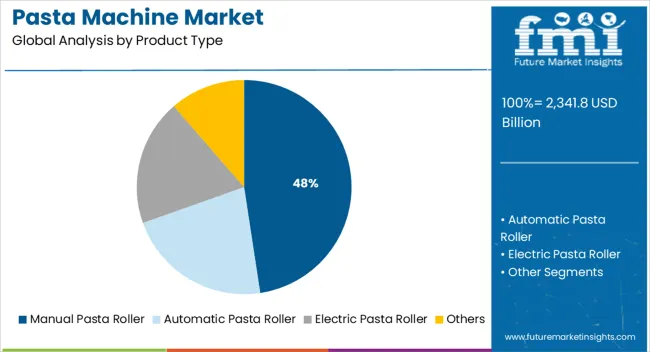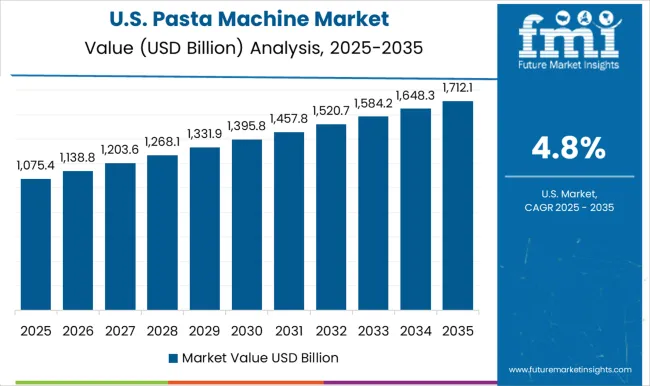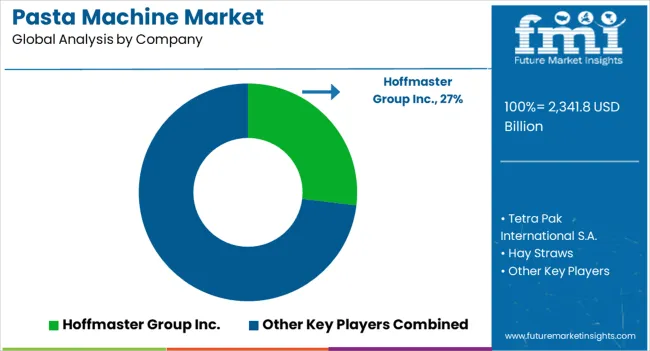The pasta machine market is estimated to be valued at USD 2341.8 billion in 2025 and is projected to reach USD 4038.2 billion by 2035, registering a compound annual growth rate (CAGR) of 5.6% over the forecast period.
The global pasta machine market demonstrates robust expansion driven by industrial food processing growth, artisanal pasta production trends, and restaurant industry demands that require specialized equipment capable of producing diverse pasta shapes, sizes, and textures while maintaining consistent quality and operational efficiency. Commercial food manufacturers implement automated pasta production lines that coordinate mixing, kneading, sheeting, and forming operations within integrated systems that maximize throughput while ensuring product uniformity across large-scale production volumes. The technology's evolution toward multi-product flexibility enables manufacturers to produce traditional pasta varieties, gluten-free alternatives, and specialty formulations using reconfigurable equipment platforms that optimize capital utilization.
Industrial pasta manufacturing represents the dominant application segment where high-capacity extrusion systems enable continuous production of dried pasta products including spaghetti, penne, fusilli, and specialty shapes requiring precise die configurations and temperature control throughout processing operations. Production managers specify equipment systems that accommodate varying wheat flour grades, protein content variations, and moisture management requirements while maintaining processing speeds necessary for commercial distribution volumes. Quality assurance protocols emphasize consistent pasta texture, cooking characteristics, and shelf stability that ensure finished products meet retail customer specifications and regulatory food safety standards.
Restaurant and foodservice markets demonstrate increasing adoption of fresh pasta machines that enable on-site production of premium pasta dishes commanding higher menu prices through superior texture and flavor characteristics compared to dried pasta alternatives. Commercial kitchen operators utilize compact pasta machines that provide production flexibility while maintaining sanitation standards necessary for food service applications. Culinary schools and training facilities invest in pasta-making equipment that enables hands-on instruction while preparing students for professional kitchen operations requiring fresh pasta preparation skills.
Competitive dynamics reflect consolidation among equipment manufacturers who acquire specialized technology companies to expand product portfolios and provide comprehensive pasta production solutions addressing complete manufacturing line requirements. Technical service capabilities increasingly differentiate suppliers as food manufacturers require comprehensive support including installation, operator training, recipe development, and ongoing maintenance services that maximize equipment productivity and product quality throughout operational lifecycles.
Distribution networks emphasize partnerships with food processing equipment dealers and culinary supply companies who provide local market knowledge and customer support capabilities essential for successful equipment implementation across diverse cultural preferences and regulatory environments governing food production operations.

| Metric | Value |
|---|---|
| Pasta Machine Market Estimated Value in (2025 E) | USD 2341.8 billion |
| Pasta Machine Market Forecast Value in (2035 F) | USD 4038.2 billion |
| Forecast CAGR (2025 to 2035) | 5.6% |
The pasta machine market is expanding steadily as consumer interest in fresh and customized food options continues to rise. Growing demand from both household and commercial users for authentic pasta preparation is supporting adoption. Manufacturers are investing in user friendly designs, advanced rollers, and durable materials to improve efficiency and ease of use.
The expansion of specialty restaurants and increasing global popularity of Italian cuisine are further strengthening market momentum. Technological advancements in semi automated and electric pasta machines are enhancing convenience while maintaining artisanal quality, appealing to diverse customer groups.
In addition, the growing trend of cooking at home, coupled with consumer preference for healthier and preservative free meals, is influencing sales across residential segments. The market outlook remains positive with opportunities for innovation in design, digital integration, and multi functionality to cater to both professional kitchens and home cooking enthusiasts.
The market is segmented by Product Type, Application, and Model and region. By Product Type, the market is divided into Manual Pasta Roller, Automatic Pasta Roller, Electric Pasta Roller, and Others. In terms of Application, the market is classified into Commercial Kitchen and Household Kitchen. Based on Model, the market is segmented into Floor Model, Mid-size Model, and Personal Model. Regionally, the market is classified into North America, Latin America, Western Europe, Eastern Europe, Balkan & Baltic Countries, Russia & Belarus, Central Asia, East Asia, South Asia & Pacific, and the Middle East & Africa.

The manual pasta roller segment is projected to hold 47.60% of total market revenue by 2025 within the product type category, making it the leading segment. Its dominance is attributed to affordability, durability, and consumer preference for traditional pasta making techniques.
The manual roller allows for precise control over dough thickness, which is highly valued by chefs and cooking enthusiasts seeking authenticity. Its ease of maintenance and long lifecycle have further reinforced adoption across households and small food outlets.
The simplicity of design and minimal requirement for electricity also make this option more accessible in emerging markets. As artisanal and home cooked food trends continue to expand, the manual pasta roller remains a preferred choice, solidifying its leadership position within the product type segment.

The commercial kitchen segment is expected to account for 58.30% of market revenue by 2025 under the application category, making it the dominant end use area. This growth is being propelled by the increasing number of restaurants, hotels, and catering services focusing on freshly prepared pasta as part of premium dining experiences.
High volume pasta preparation in commercial kitchens demands reliable, durable, and high output machines. The integration of pasta machines in professional kitchens has reduced preparation time while maintaining consistent quality, driving their preference among chefs.
Strong emphasis on menu diversification and consumer preference for authentic dining has also reinforced adoption. Consequently, commercial kitchens continue to dominate demand due to their scale, operational efficiency needs, and contribution to customer satisfaction.

The floor model segment is anticipated to represent 42.70% of the total market by 2025 within the model category, positioning it as the leading model type. Floor models are favored for their high capacity, robust construction, and suitability for continuous operation in commercial environments.
Their ability to handle large volumes efficiently has made them indispensable for restaurants, pasta shops, and institutional kitchens. Enhanced stability, long operating life, and adaptability to multiple pasta shapes further add to their utility.
Investments by foodservice providers in high performance pasta equipment are reinforcing demand for floor models. With the rise of large scale food production and consistent consumer appetite for fresh pasta, the floor model continues to lead as the preferred option within the model category.
As per Future Market Insights, over the past five years, the global market for pasta machines grew at a considerable pace owing to significant changes in consumption patterns. Increasing concerns about the environment are projected to decline the need for meat-based food products, which is likely to drive pasta machine sales.
Consumers are nowadays shifting towards plant-based food products and are also following a vegetarian or vegan diet. Pasta is considered to be an integral part of the vegetarian or vegan diet as it is a rich source of carbohydrates.
The rising trend for pairing pasta with other food items such as garlic bread, salads, and soups is another vital factor that is projected to drive the demand for pasta machines in the next ten years. Manufacturers are expected to focus on expanding their product portfolios by launching new product varieties infused with organic ingredients such as organic wheat to cater to market requirements.
Various factors have been evaluated to stir things up in the market for pasta machines. Lead analysts at Future Market Insights have evaluated the driving factors, growth opportunities, hindrances, and future challenges that can affect the global market.
The drivers, restraints, opportunities, and threats identified in the report are as follows:
DRIVERS
RESTRAINTS
OPPORTUNITIES
THREATS

High Demand for Pasta Salads across the USA to Push Sales of Electric Pasta Machines
According to Future Market Insights, the pasta machine market in the USA is projected to grow at a CAGR of 68% in the next ten years and reach USD 4038.2 million by 2035. Rising consciousness about the effect of regular consumption of pasta made with new varieties of whole grains is likely to drive sales. Increasing demand for pasta salads and other new recipes is another vital factor that would propel the USA market.
Pasta Roller Machines to Witness Exponential Demand in India as Consumers Adopt Busy Lifestyles
Due to the rapidly rising population and people’s busy schedules, the demand for pasta has been increasing at regular intervals across India. It is further manipulating medium- and small-sized companies to partake in the country’s pasta machine industry. International players are looking to establish their presence in the Indian market by expanding their robust distribution channels to improve access to the local industry.

Surging Demand for Dried Pasta due to its High Freshness across Germany Would Propel Sales of Pasta Making Machines
According to Future Market Insights, the pasta machine market is expected to grow at a CAGR of 5.6% across Germany. The country is projected to grow positively throughout the estimated time frame amid increasing demand for dried pasta. Dried pasta is considered to be a healthier choice, as compared to their fresh counterparts in Germany as they often undergo minimal processing. Owing to the aforementioned factors, the county is estimated to grow at a rapid pace in the forecast period.
High Demand for Dried Pasta in China to Propel Need for Italian Pasta Machines
According to Future Market Insights, the pasta machine market in China is expected to grow at a steady pace during the assessment period. This growth is attributed to the increasing adoption of western culture by people across China. High demand for dried pasta for home usage is anticipated to propel the need for pasta machines in the country. The availability of dried noodles for making several dishes such as spaghetti meals with meatballs, soups, and casseroles is another factor that would aid sales.
Sales of Pasta Makers to Rise as Celebrity Chefs across the United Kingdom Collaborate with Food Delivery Platforms
During the projected period, the United Kingdom is expected to be one of the fastest-developing markets. As per Future Market Insights, the United Kingdom pasta machine market is set to surge at a valuation of around USD 184.8 million by 2035.
The country’s pasta machine industry is set to be pushed by increasing demand for pasta in full-service restaurants, cafeterias, quick-service restaurants, and hotels. Numerous social media influencers and celebrities are expected to tie up with leading pasta brands to launch new products.
In October 2025, for instance, Jamie Oliver, a restaurateur, and chef teamed up with Taster, a renowned United Kingdom-based delivery-first kitchen group, to introduce a novel pasta concept. Pasta Dreams is set to be open for consumers to order from leading delivery platforms such as Uber Eats.

The pasta machine market is led by Italian manufacturers known for precision engineering, innovation, and strong craftsmanship traditions. Marcato S.r.l. dominates the global household pasta machine segment with its high-quality manual and electric pasta makers, recognized for durability, precision, and design aesthetics. The company’s focus on consumer-friendly models and export expansion strengthens its leadership in both retail and professional kitchen markets.
ITALGI S.r.l. and Bottene SNC hold strong positions in the commercial and artisanal pasta production segment, offering industrial-grade machines for fresh and dry pasta manufacturing. Their equipment integrates automation and customizable configurations suitable for restaurants and medium-scale production facilities. Italpast S.r.l. specializes in fully automated industrial pasta lines, providing turnkey solutions for large-scale production, while Imperia & Monferrina S.p.A. combines traditional craftsmanship with modern automation to serve both domestic and industrial users.
La Parmigiana S.r.l. and Pama Roma S.r.l. focus on continuous innovation in extrusion technology, offering machines capable of producing a wide variety of pasta shapes with consistent texture and output quality. Fimar S.p.A. delivers reliable, cost-effective machines for small and medium-sized businesses, emphasizing ease of use and maintenance. Pastaline S.r.l. and Dominioni Punto & Pasta S.r.l. cater to artisanal and gourmet pasta producers with compact, versatile machines designed for customization and efficiency.
| Attribute | Details |
|---|---|
| Estimated Market Size (2025) | USD 2341.8 billion |
| Projected Market Valuation (2035) | USD 4038.2 billion |
| Value-based CAGR (2025 to 2035) | 5.6% |
| Forecast Period | 2025 to 2035 |
| Historical Data Available for | 2020 to 2025 |
| Market Analysis | Value (USD million) |
| Key Regions Covered |
North America; Latin America; Europe; Asia Pacific; Oceania; Middle East and Africa (MEA) |
| Key Countries Covered |
United States of America, Canada, Mexico, Germany, United Kingdom, France, Italy, Spain, China, Japan, India, South Korea, Australia, Brazil, Argentina, South Africa, UAE |
| Key Segments Covered |
Product Type, Model, Application, Region |
| Key Companies Profiled |
Marcato S.r.l., ITALGI S.r.l., Bottene SNC, Italpast S.r.l., Imperia & Monferrina S.p.A., La Parmigiana S.r.l., Pama Roma S.r.l., Fimar S.p.A., Pastaline S.r.l., and Dominioni Punto & Pasta S.r.l. |
| Report Coverage | Market Forecast, Company Share Analysis, Competitive Landscape, Drivers, Restraints, Opportunities and Threats Analysis, Market Dynamics and Challenges, and Strategic Growth Initiatives |
The global pasta machine market is estimated to be valued at USD 2,341.8 billion in 2025.
The market size for the pasta machine market is projected to reach USD 4,038.2 billion by 2035.
The pasta machine market is expected to grow at a 5.6% CAGR between 2025 and 2035.
The key product types in pasta machine market are manual pasta roller, automatic pasta roller, electric pasta roller and others.
In terms of application, commercial kitchen segment to command 58.3% share in the pasta machine market in 2025.






Full Research Suite comprises of:
Market outlook & trends analysis
Interviews & case studies
Strategic recommendations
Vendor profiles & capabilities analysis
5-year forecasts
8 regions and 60+ country-level data splits
Market segment data splits
12 months of continuous data updates
DELIVERED AS:
PDF EXCEL ONLINE
Pasta Sauces Market Size and Share Forecast Outlook 2025 to 2035
Pasta and Noodles Market Analysis by Product Type, Usage, Distribution Channel, and Region Through 2035
Vegan Pasta Market Size and Share Forecast Outlook 2025 to 2035
Vegan Pasta Sauce Market Expansion - Dairy-Free & Plant-Based Sauces 2025 to 2035
Canned Pasta Market Trends - Convenience & Consumer Preferences 2025 to 2035
Uncooked Pasta and Noodles Market Size and Share Forecast Outlook 2025 to 2035
Gluten-Free Pasta Market Trends - Health-Conscious Eating & Market Growth 2025 to 2035
Machine Glazed Paper Market Size and Share Forecast Outlook 2025 to 2035
Machine Glazed Kraft Paper Market Forecast and Outlook 2025 to 2035
Machine Condition Monitoring Market Size and Share Forecast Outlook 2025 to 2035
Machine Glazed Paper Industry Analysis in Asia Pacific Forecast Outlook 2025 to 2035
Machine Vision Camera Market Size and Share Forecast Outlook 2025 to 2035
Machine Tool Oils Market Size and Share Forecast Outlook 2025 to 2035
Machine Vision System And Services Market Size and Share Forecast Outlook 2025 to 2035
Machine Glazed Paper Industry Analysis in Western Europe Size and Share Forecast Outlook 2025 to 2035
Machine Glazed Paper Industry Analysis in Korea Size and Share Forecast Outlook 2025 to 2035
Machine Glazed Paper Industry Analysis in Japan Size and Share Forecast Outlook 2025 to 2035
Machine Tool Cooling System Market Analysis - Size, Share, and Forecast Outlook 2025 to 2035
Machine Tool Touch Probe Market Analysis - Size, Growth, and Forecast 2025 to 2035
Machine Mount Market Analysis - Size & Industry Trends 2025 to 2035

Thank you!
You will receive an email from our Business Development Manager. Please be sure to check your SPAM/JUNK folder too.
Chat With
MaRIA